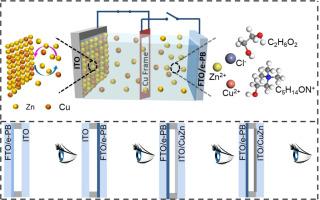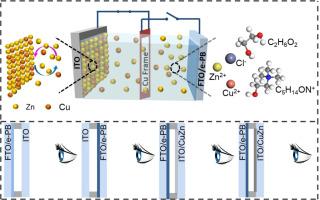Multi-component deep eutectic solvents achieve high stability zinc deposition and dissolution for electrochromic devices
IF 5.6
3区 材料科学
Q1 ELECTROCHEMISTRY
引用次数: 0
Abstract
Electrochromic devices based on reversible metal deposition offer superior optical performance, with higher reflectivity and broader modulation ranges than conventional ion intercalation systems. Traditional devices use pre-deposited electrochromic layers on transparent conductive substrates, limited by material properties and ion migration rates. In contrast, metal deposition and dissolution devices achieve rapid, highly reversible color switching by directly controlling metal electrochemical deposition on transparent electrodes, expanding modulation range and response speed. This study proposes a multi-component deep eutectic solvent (MDES) electrolyte enabling reversible, efficient, dense zinc deposition, overcoming loose morphology, low transmittance, and low efficiency issues in aqueous electrolytes. MDES raises zinc nucleation overpotential, promotes fine, uniform particles, decreases light transmission, and enhances modulation depth; it also inhibits hydrogen evolution and zinc corrosion, improving stability and cycling. Trace Cu²⁺ further optimizes zinc kinetics, reduces interfacial polarization, and boosts reversibility and device efficiency. Using this electrolyte, a three-electrode multispectral device was assembled, showing four distinct optical states: fully transparent, semi-transparent blue, intermediate opacity, and nearly opaque. This enables dynamic visible and near-infrared light modulation, enhancing adaptive optical application potential. The work offers new design insights for metal-based reversible electrochemical systems, advancing smart windows, tunable filters, and energy-efficient displays with broad prospects.


多组分深共晶溶剂实现电致变色器件的高稳定性锌沉积和溶解
基于可逆金属沉积的电致变色器件具有比传统离子嵌入系统更高的反射率和更宽的调制范围,具有优越的光学性能。传统器件在透明导电衬底上预先沉积电致变色层,受材料性质和离子迁移速率的限制。相比之下,金属沉积和溶解器件通过直接控制透明电极上的金属电化学沉积,扩大调制范围和响应速度,实现了快速、高度可逆的颜色切换。本研究提出了一种多组分深共晶溶剂(MDES)电解质,可实现可逆、高效、致密的锌沉积,克服了水性电解质中形貌松散、透光率低和效率低等问题。MDES提高锌成核过电位,促进颗粒细均匀,降低透光率,提高调制深度;它还抑制析氢和锌腐蚀,提高稳定性和循环。微量Cu 2 +进一步优化了锌的动力学,降低了界面极化,提高了可逆性和器件效率。利用这种电解质,组装了一个三电极多光谱器件,显示出四种不同的光学状态:完全透明、半透明蓝色、中间不透明和几乎不透明。这使得动态可见光和近红外光调制成为可能,增强了自适应光学的应用潜力。这项工作为金属基可逆电化学系统、先进的智能窗口、可调谐滤波器和节能显示器提供了新的设计见解,具有广阔的前景。
本文章由计算机程序翻译,如有差异,请以英文原文为准。
求助全文
约1分钟内获得全文
求助全文
来源期刊

Electrochimica Acta
工程技术-电化学
CiteScore
11.30
自引率
6.10%
发文量
1634
审稿时长
41 days
期刊介绍:
Electrochimica Acta is an international journal. It is intended for the publication of both original work and reviews in the field of electrochemistry. Electrochemistry should be interpreted to mean any of the research fields covered by the Divisions of the International Society of Electrochemistry listed below, as well as emerging scientific domains covered by ISE New Topics Committee.
 求助内容:
求助内容: 应助结果提醒方式:
应助结果提醒方式:


